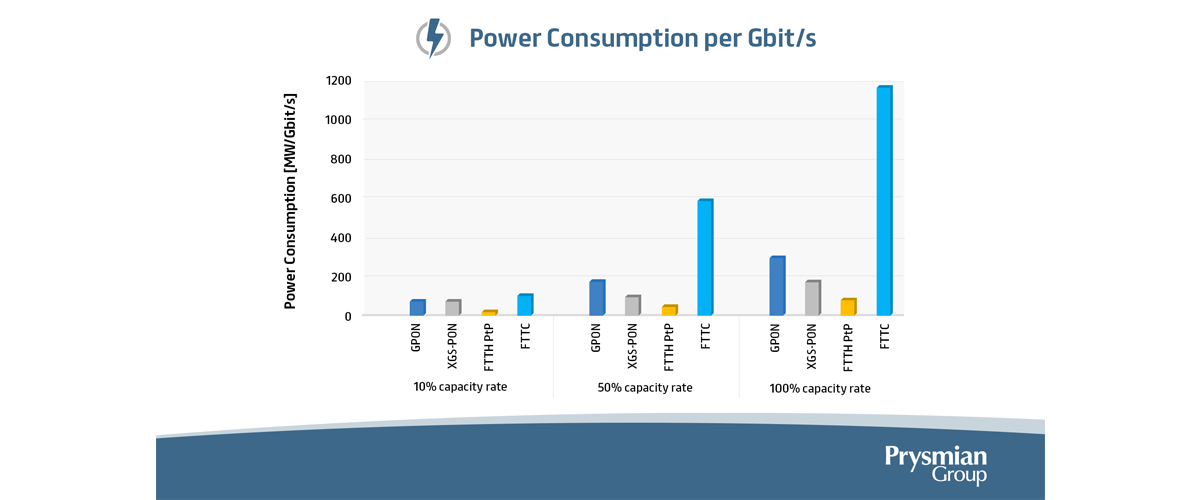Prysmian Group study: TCO, sustainability and cable choice


As new technologies such as 5G are rolled out and the adoption of IoT, edge computing and working from home continues to grow, people expect high-speed, low-latency, always-available bandwidth everywhere. This requires vast amounts of backhaul cabling and network densification. On the one hand, more connectivity is needed, while on the other hand, cost and environmental aspects must be observed.
How does energy consumption relate to selecting of cable for increasing density, reducing carbon emissions and reducing cost? And what is the technological impact of different access technologies on the actual infrastructure and the derived power consumption? To find out, a full-scale rollout of three access technologies at a suitable area was compared and access data analysed across an actual existing region. Different settlement structures were available across the chosen regions – rural, urban and business parks – which contains six municipalities
FTTH proved to be the most Energy-Efficient Access Network, with a per capita consumption between 56 kWh/year und 88 kWh/year. FTTH GPON is by far the most energy-efficient access network. FTTH Point to Point can offer the highest data rates - even symmetrical in down- and upstream – and can, therefore, transmit the greatest amount of data. Figures from a different study shared by Huawei comparing copper Vectoring / G.fast technology, DOCSIS and FTTH GPON explain that the latter uses 60%-75% less energy than vectoring and 70%-85% less than DOCSIS.
The following access technologies were evaluated:
- VDSL2-Vectoring
- HFC with DOCSIS 3.0 @864MHz
- FTTH as Point to Point
- FTTH as GPON

There is a need for higher bandwidth and more connections, but without using up more space, and without placing a huge burden on the environment. To really keep up with current and future demand, innovation is essential. One important area is increasing fibre count without changing fibre diameter – or reducing diameter while retaining fibre count. TCO reduction is also essential – by examining all aspects of TCO it is possible to reduce this and do more with less. Furthermore, to keep expanding and rolling out networks while reducing carbon footprint, a Circular Economy approach is essential. Let’s take a closer look at these aspects.
Fibre density is being successfully reduced by introducing ultra-compact cable designs. Currently Fibre Densities of up to 7.5 fibres per mm2 are available and these figures are expected to be even lower in future. As duct sizes become smaller, vast amounts of material are saved. In addition, Smart Drums provide full inventory management, whilst helping reduce the total cost of cable management through improved asset use and operating efficiency. The resulting optimised logistics and minimised cable waste and scrap help reduce environmental impact.
The study defined the access network as follows:
- Aggregation in the central office
- Line termination at the customers premises
- Every electrical component in between to enable a data transfer
Within the six municipalities nearly 17,000 properties with some 26,000 households, business units etc. exist. 16,755 of these properties and 25,311 connections could be geographically referenced. Properties are referred to as connection points. Households, business units are equal to the actual subscribers behind a connection point. The geographically referenced connection points and subscribers build the data basis for all further evaluation.
A downstream data rate of 50 Mbit/s was selected as a reference value.


FTTH technologies are more sustainable than FTTC networks in every scenario - nationwide, urban, rural - and for almost every capacity rate.
Based on the electricity consumption per bitrate, copper-based access networks consume three to seventeen times more electricity than fibre networks at 50% to 100% average capacity rate.
Based on the weight of the system technology, the report shows that the material usage of fibre-based networks is, at most, only 1/3 of the material usage of copper-based networks at 50% to 100% average capacity rate.
Source: BREKO German Broadband Association
A study by the US Fiber Broadband Association study confirms network operator claims about OpEx savings using FTTH versus other technologies, with savings ranging from 40-60% versus copper-based networks. This saving is primarily accrued from the maintenance, powering, customer experience, support, and churn advantages of fibre.




